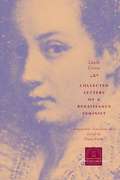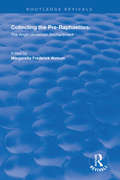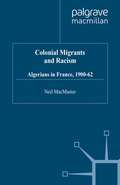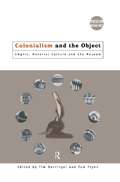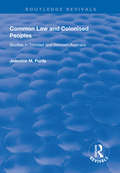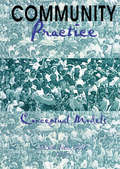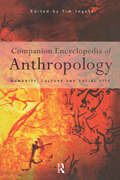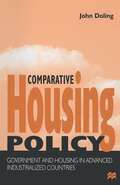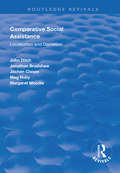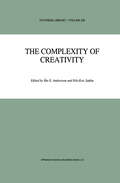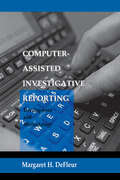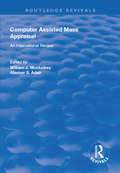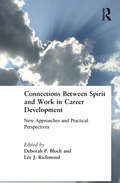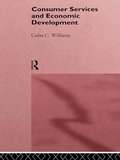- Table View
- List View
Collected Letters of a Renaissance Feminist (The Other Voice in Early Modern Europe)
by Laura CeretaRenaissance writer Laura Cereta (1469–1499) presents feminist issues in a predominantly male venue—the humanist autobiography in the form of personal letters. Cereta's works circulated widely in Italy during the early modern era, but her complete letters have never before been published in English. In her public lectures and essays, Cereta explores the history of women's contributions to the intellectual and political life of Europe. She argues against the slavery of women in marriage and for the rights of women to higher education, the same issues that have occupied feminist thinkers of later centuries. Yet these letters also furnish a detailed portrait of an early modern woman’s private experience, for Cereta addressed many letters to a close circle of family and friends, discussing highly personal concerns such as her difficult relationships with her mother and her husband. Taken together, these letters are a testament both to an individual woman and to enduring feminist concerns.
Collected Letters of a Renaissance Feminist (The Other Voice in Early Modern Europe)
by Laura CeretaRenaissance writer Laura Cereta (1469–1499) presents feminist issues in a predominantly male venue—the humanist autobiography in the form of personal letters. Cereta's works circulated widely in Italy during the early modern era, but her complete letters have never before been published in English. In her public lectures and essays, Cereta explores the history of women's contributions to the intellectual and political life of Europe. She argues against the slavery of women in marriage and for the rights of women to higher education, the same issues that have occupied feminist thinkers of later centuries. Yet these letters also furnish a detailed portrait of an early modern woman’s private experience, for Cereta addressed many letters to a close circle of family and friends, discussing highly personal concerns such as her difficult relationships with her mother and her husband. Taken together, these letters are a testament both to an individual woman and to enduring feminist concerns.
Collecting the Pre-Raphaelites: The Anglo-American Enchantment (Routledge Revivals)
by Margaretta Frederick WatsonFirst published in 1997, and written by leading scholars of the day , these fifteen essays examine aspects of the reception and collecting of Pre-Raphaelite Art, the social and cultural context in which the work was favoured and acquired. Two major collections provide the focus for the investigation: that of the Birmingham city Museums and Art Gallery in the United Kingdom, and that of the American Samuel Bancroft Jr, now part of the Delaware Art Museum. The study of these two collections both formed in the late 1890’, places Pre-Raphaelite Art at nexus of contemporary cultural issues that touched the lives of both the city council, intent on establishing a public gallery of national importance, and a wealthy American businessman, indulging a private passion for the work of these artists. The contributors approach the issue in a variety of ways, These include the study of the ambitions and self-perception of collectors of the period, an analysis of the impact of John Ruskin’s campaign to establish Pre-Raphaelite painting as the ‘Art of England’ , and its impact on notions of civic and national identity ; the examination of individual painting in relation to such issues as the portrayal of women, the nude and of religious subjects ; and the study of the Victorian preoccupation with Renaissance Italy and the attempt by Ruskin, Charles Fairfax Murray , advisor to the two collections, and the Grosvenor Gallery, to proclaim the Pre-Raphaelite artists as the true inheritors of the ‘genius’ of Renaissance Italian artists.These essays were first presented at a symposium held at the Delaware Art Museum during the exhibition there of the paintings of Birmingham City Museums and Art Gallery.
Collecting the Pre-Raphaelites: The Anglo-American Enchantment (Routledge Revivals)
by Margaretta Frederick WatsonFirst published in 1997, and written by leading scholars of the day , these fifteen essays examine aspects of the reception and collecting of Pre-Raphaelite Art, the social and cultural context in which the work was favoured and acquired. Two major collections provide the focus for the investigation: that of the Birmingham city Museums and Art Gallery in the United Kingdom, and that of the American Samuel Bancroft Jr, now part of the Delaware Art Museum. The study of these two collections both formed in the late 1890’, places Pre-Raphaelite Art at nexus of contemporary cultural issues that touched the lives of both the city council, intent on establishing a public gallery of national importance, and a wealthy American businessman, indulging a private passion for the work of these artists. The contributors approach the issue in a variety of ways, These include the study of the ambitions and self-perception of collectors of the period, an analysis of the impact of John Ruskin’s campaign to establish Pre-Raphaelite painting as the ‘Art of England’ , and its impact on notions of civic and national identity ; the examination of individual painting in relation to such issues as the portrayal of women, the nude and of religious subjects ; and the study of the Victorian preoccupation with Renaissance Italy and the attempt by Ruskin, Charles Fairfax Murray , advisor to the two collections, and the Grosvenor Gallery, to proclaim the Pre-Raphaelite artists as the true inheritors of the ‘genius’ of Renaissance Italian artists.These essays were first presented at a symposium held at the Delaware Art Museum during the exhibition there of the paintings of Birmingham City Museums and Art Gallery.
Colonial Migrants and Racism: Algerians in France, 1900–62
by N. MacMasterThe first comprehensive study in English of the earliest and largest 'Third-World' migration into pre-war Europe. Full attention is given to the relationship between the society of emigration, undermined by colonialism, and processes of ethnic organisation in the metropolitan context. Contemporary anti-Algerian racism is shown to have deep roots in moves by colonial elites to control and police the migrants and to segregate them from contact with Communism, nationalist movements and the French working class.
Colonialism and the Object: Empire, Material Culture and the Museum (Museum Meanings)
by Tim Barringer Tom FlynnDrawing together an international group of scholars from a variety of disciplinary and cultural backgrounds, Colonialism and the Object explores the impact of colonial contact with other cultures on the material culture of both the colonized and the imperial nation. The book includes intensive case-studies of objects from India, Pakistan, New Zealand, China and Africa, all of which were collected by, or exhibited in, the institutions of the British Empire, and key chapters address issues of radical identity across cultural barriers, and the hybird styles of objects which can emerge when cultures meet. Colonialism and the Object is essential reading for all those interested in post-colonial theory, museum studies, material culture and design history.
Colonialism and the Object: Empire, Material Culture and the Museum (Museum Meanings)
by Tim Barringer Tom FlynnDrawing together an international group of scholars from a variety of disciplinary and cultural backgrounds, Colonialism and the Object explores the impact of colonial contact with other cultures on the material culture of both the colonized and the imperial nation. The book includes intensive case-studies of objects from India, Pakistan, New Zealand, China and Africa, all of which were collected by, or exhibited in, the institutions of the British Empire, and key chapters address issues of radical identity across cultural barriers, and the hybird styles of objects which can emerge when cultures meet. Colonialism and the Object is essential reading for all those interested in post-colonial theory, museum studies, material culture and design history.
Common Law and Colonised Peoples: Studies in Trinidad and Western Australia (Routledge Revivals)
by Jeannine M. PurdyPublished in 1997. It is well known in Australia that Aboriginal people are currently massively over-represented amongst the prison population. Although it is not officially acknowledged to the same degree in Trinidad, it is also well-known that Afro-Trinidadians are over-represented in the prisons of that county. The disproportionate criminalisation of Aboriginal Australians and Afro-Trinidadians is interpreted by the author as a continuation and concretion of the myth of the barbaric, uncivilised and ungoverned ‘savage; in opposition to which Western legal systems and societies have created their own identities. The book departs from much contemporary analysis in this area by drawing strongly upon a historical analysis of the operations of the common law in Trinidad and Western Australia. By doing so, the book illustrates that race/ethnicity and criminalisation are not necessarily contiguous. What such analysis does reveal is another and more constant dimension to criminalisation; and that is economic basis of many of the legal relations instituted under British derived legal systems with respect to colonised peoples.
Common Law and Colonised Peoples: Studies in Trinidad and Western Australia (Routledge Revivals)
by Jeannine M. PurdyPublished in 1997. It is well known in Australia that Aboriginal people are currently massively over-represented amongst the prison population. Although it is not officially acknowledged to the same degree in Trinidad, it is also well-known that Afro-Trinidadians are over-represented in the prisons of that county. The disproportionate criminalisation of Aboriginal Australians and Afro-Trinidadians is interpreted by the author as a continuation and concretion of the myth of the barbaric, uncivilised and ungoverned ‘savage; in opposition to which Western legal systems and societies have created their own identities. The book departs from much contemporary analysis in this area by drawing strongly upon a historical analysis of the operations of the common law in Trinidad and Western Australia. By doing so, the book illustrates that race/ethnicity and criminalisation are not necessarily contiguous. What such analysis does reveal is another and more constant dimension to criminalisation; and that is economic basis of many of the legal relations instituted under British derived legal systems with respect to colonised peoples.
Community Practice: Conceptual Models
by Marie WeilHere is the only book that gives you a comparison of model frameworks and a critique of multiple perspectives. Community Practice: Conceptual Models (along with its companion volume, Community Practice: Models in Action) illustrates the diverse ways that community practice is conceived and delineates both the central and subtle differences among models to guide community assessment, action planning, and practice. By knitting together the complex ideas from the social sciences and community practice, this book shows how to combine these ideas to improve teaching, practice, analysis, and research for social work faculty; social work students; practitioners in community work, administration, and social planning; and faculty of related disciplines.The scope of Community Practice: Conceptual Models is broad, providing the first historical report on model development and implementation since 1965. Its chapters present diverse views on community practice approaches and provide the compilation, critique, and analysis of current models --while illustrating how these approaches developed over time. Included is Rothman’s long-awaited revision and elaboration of his 1970s classic, three models conceptual framework. Other vital topics you learn about include: collaborative community development social planning, reform movements, and social action ecological theory in community practice a feminist response and critique to Rothman’s approaches to community intervention a comparison of community practice in the U.S. and U.K., with an emphasis on nonracist practice and community-based service developmentCommunity Practice: Conceptual Models offers challenges and indicates directions for practice, theory elaboration, testing, and research and shows community practice in relation to characteristics such as goals and desired outcomes, change strategies, targets of change, primary constituencies, and focus or scope of concern. This book provides the strongest perspectives on community practice to help you improve your practice, assessments, action plans, and research.
Community Practice: Conceptual Models
by Marie WeilHere is the only book that gives you a comparison of model frameworks and a critique of multiple perspectives. Community Practice: Conceptual Models (along with its companion volume, Community Practice: Models in Action) illustrates the diverse ways that community practice is conceived and delineates both the central and subtle differences among models to guide community assessment, action planning, and practice. By knitting together the complex ideas from the social sciences and community practice, this book shows how to combine these ideas to improve teaching, practice, analysis, and research for social work faculty; social work students; practitioners in community work, administration, and social planning; and faculty of related disciplines.The scope of Community Practice: Conceptual Models is broad, providing the first historical report on model development and implementation since 1965. Its chapters present diverse views on community practice approaches and provide the compilation, critique, and analysis of current models --while illustrating how these approaches developed over time. Included is Rothman’s long-awaited revision and elaboration of his 1970s classic, three models conceptual framework. Other vital topics you learn about include: collaborative community development social planning, reform movements, and social action ecological theory in community practice a feminist response and critique to Rothman’s approaches to community intervention a comparison of community practice in the U.S. and U.K., with an emphasis on nonracist practice and community-based service developmentCommunity Practice: Conceptual Models offers challenges and indicates directions for practice, theory elaboration, testing, and research and shows community practice in relation to characteristics such as goals and desired outcomes, change strategies, targets of change, primary constituencies, and focus or scope of concern. This book provides the strongest perspectives on community practice to help you improve your practice, assessments, action plans, and research.
Companion Encyclopaedia of Anthropology
by Tim IngoldThis comprehensive survey of contemporary thought in biological, social and cultural anthropology sets the foundation for their future development and integration. The principal rationale behind the Encyclopedia is to overcome the division and fragmentation within the approaches of the humanities and natural sciences to anthropology. It emphasizes interconnections between perspectives and sub-disciplines, producing a complete perspective on what it means to be human. The work consists of three parts--Humanity, Culture, and Social Life--and 40 major contributions. Part One emphasizes human beings as members of a species, how that species differs from others, how it has evolved, and how human populations have adapted to and in turn transformed their environments. Part Two deals with the origin and structure of human culture, and on the role of culture in action, perception, and cognition. Part Three examines the various aspects of the relationships and processes that are carried on by persons and groups in the course of social life. Useful features such as cross-references within the text, full biographical references, suggestions for further reading and carefully illustrated line drawings make this an indispensable resource for all students of anthropology or sociology.
Companion Encyclopaedia of Anthropology: Humanity, Culture And Social Life
by Tim IngoldThis comprehensive survey of contemporary thought in biological, social and cultural anthropology sets the foundation for their future development and integration. The principal rationale behind the Encyclopedia is to overcome the division and fragmentation within the approaches of the humanities and natural sciences to anthropology. It emphasizes interconnections between perspectives and sub-disciplines, producing a complete perspective on what it means to be human. The work consists of three parts--Humanity, Culture, and Social Life--and 40 major contributions. Part One emphasizes human beings as members of a species, how that species differs from others, how it has evolved, and how human populations have adapted to and in turn transformed their environments. Part Two deals with the origin and structure of human culture, and on the role of culture in action, perception, and cognition. Part Three examines the various aspects of the relationships and processes that are carried on by persons and groups in the course of social life. Useful features such as cross-references within the text, full biographical references, suggestions for further reading and carefully illustrated line drawings make this an indispensable resource for all students of anthropology or sociology.
The Company She Keeps (UK Higher Education OUP Humanities & Social Sciences Women's Studies)
by Valerie HeyThis lively and revealing study explores a sociologically invisible but important social relationship: girls' friendships. It uncovers often suppressed school-girl cultures, at times representing in their most condensed and dramatic form issues of intimacy, secrecy and struggle. Most women have memories of, and most mothers of young daughters become re-immersed in, these all-consuming but little understood passions. This taken-for-granted 'ordinary' relationship is examined using girls' notes, talk, diaries and interviews gathered by observing girls groups within city schools.An important and previously ignored question is addressed by examining how girls' intimacy is structured through class, gender, sexuality and race, especially its paradoxical role in maintaining and challenging 'compulsory heterosexuality'. In this way, a series of case studies analyses how girls variously come to understand and construct "difference". In addition, this detailed analysis of girls' friendship contributes to our understanding of how girls simultaneously survive their schools, their families, their relations and subordination to boys and men.Valerie Hey returns the reader to the terrain of loss and recollection, of girls' pleasure and pain in their friendship, and asserts the claims of the social through identifying how this is written into the cultural forms of girls' relationships with each other. Students of women's studies, education, sociology and social psychology will find this book to be an invaluable exploration of how every-day 'obvious' experience is played out as forms of subjectivity and power.
Comparative Housing Policy: Government and Housing in Advanced Industrialized Countries
by John DolingThis text introduces the reader to the comparative study of housing policy. It looks first at the benefits, limitations and difficulties of the comparative method, as well as the reasons behind governmental involvement in housing and particular policy choices. It then identifies and discusses key themes of value to the analysis of a range of countries in the advanced capitalist world, offering an understanding of national differences and similarities and drawing on examples from, for instance, Europe, the USA, Australia and Japan.
Comparative Social Assistance: Localisation and Discretion (Routledge Revivals)
by John Ditch Jonathan Bradshaw Jochen Clasen Meg Huby Margaret MoodiePublished in 1997, the is the report of a study commissioned by the Department of Social Security (UK). The aim of the study was to provide detailed information about the social assistance systems of four European countries which, to a greater or lesser extent, are delegated to local levels of government. The study distinguished between policy-making, finances, delivery and accountability. The strengths and weaknesses of each system were evaluated and common and divergent trends noted. There is growing interest in social assistance schemes internationally and this publication provides original information about European schemes. It follows an earlier study, also commissioned by the DSS, on social assistance schemes in 24 OECD countries.
Comparative Social Assistance: Localisation and Discretion (Routledge Revivals)
by John Ditch Jonathan Bradshaw Jochen Clasen Meg Huby Margaret MoodiePublished in 1997, the is the report of a study commissioned by the Department of Social Security (UK). The aim of the study was to provide detailed information about the social assistance systems of four European countries which, to a greater or lesser extent, are delegated to local levels of government. The study distinguished between policy-making, finances, delivery and accountability. The strengths and weaknesses of each system were evaluated and common and divergent trends noted. There is growing interest in social assistance schemes internationally and this publication provides original information about European schemes. It follows an earlier study, also commissioned by the DSS, on social assistance schemes in 24 OECD countries.
The Complexity of Creativity (Synthese Library #258)
by Ake E. Andersson N. E. SahlinThis is a volume on the concepts, theories, models and social consequences of creativity. It contains articles by well-known cognitive scientists, economists, mathematicians, philosophers and psychologists.
Computer-assisted Investigative Reporting: Development and Methodology
by Margaret H. DeFleurConducting computer analyses for the purposes of revealing information of significance to the press represents an extension of one of the most important forms of American journalism into the contemporary era of new technologies. Investigative reporting had its start with the establishment of the metropolitan newspaper during the early decades of the 1900s. At the time, it was a continuation of the evolving tradition of freedom of the press that had characterized American political life since colonial times. As it developed, investigative reporting stressed facts rather than the opinions of the editor or reporter. In turn, that tradition had its own intellectual roots. Today, computer-assisted investigative reporting (CAIR) extends that "marketplace of ideas" into systematic examinations of the electronic records of government. In addition, computer analyses of other kinds of information systematically gathered by journalists can provide the press with insights into trends and patterns unlikely to be revealed by other means. This unique volume addresses procedures and issues in investigative journalism that have not been explained in other publications. It sets forth -- for the first time -- a detailed and specific methodology for conducting computer-assisted investigative analyses of both large and small scale electronic records of government and other agencies. That methodology consists of the logic of inquiry, strategies for reaching valid conclusions, and rules for reporting what has been revealed by the analyses to the public in clear ways. Such systematic methodologies are essential in social and other sciences and the development of a counterpart for investigative journalism has been badly needed. That systematic methodology is developed within a context that explains the origin and major characteristics of those elements that have come together in American society to make computer-assisted investigative reporting both possible and increasingly a part of standard newsroom practices. These include the development of traditional investigative journalism, the evolution of computer technology, the use of computers by government to keep records, the legal evolution of freedom of information laws, the rapid adoption of computers in newsrooms, the increasing importance of precision journalism, and the sharp increase in recent times of computer-assisted investigative reporting by American newspapers both large and small. The issues addressed in this book are discussed in a very readable context with an abundance of examples and illustrations drawn from the real world of journalism as it is practiced daily in newsrooms around the country. Explanations of concepts, principles, and procedures are set forth in layperson's terms that require very little in the way of knowledge of computers or statistical methods.
Computer-assisted Investigative Reporting: Development and Methodology
by Margaret H. DeFleurConducting computer analyses for the purposes of revealing information of significance to the press represents an extension of one of the most important forms of American journalism into the contemporary era of new technologies. Investigative reporting had its start with the establishment of the metropolitan newspaper during the early decades of the 1900s. At the time, it was a continuation of the evolving tradition of freedom of the press that had characterized American political life since colonial times. As it developed, investigative reporting stressed facts rather than the opinions of the editor or reporter. In turn, that tradition had its own intellectual roots. Today, computer-assisted investigative reporting (CAIR) extends that "marketplace of ideas" into systematic examinations of the electronic records of government. In addition, computer analyses of other kinds of information systematically gathered by journalists can provide the press with insights into trends and patterns unlikely to be revealed by other means. This unique volume addresses procedures and issues in investigative journalism that have not been explained in other publications. It sets forth -- for the first time -- a detailed and specific methodology for conducting computer-assisted investigative analyses of both large and small scale electronic records of government and other agencies. That methodology consists of the logic of inquiry, strategies for reaching valid conclusions, and rules for reporting what has been revealed by the analyses to the public in clear ways. Such systematic methodologies are essential in social and other sciences and the development of a counterpart for investigative journalism has been badly needed. That systematic methodology is developed within a context that explains the origin and major characteristics of those elements that have come together in American society to make computer-assisted investigative reporting both possible and increasingly a part of standard newsroom practices. These include the development of traditional investigative journalism, the evolution of computer technology, the use of computers by government to keep records, the legal evolution of freedom of information laws, the rapid adoption of computers in newsrooms, the increasing importance of precision journalism, and the sharp increase in recent times of computer-assisted investigative reporting by American newspapers both large and small. The issues addressed in this book are discussed in a very readable context with an abundance of examples and illustrations drawn from the real world of journalism as it is practiced daily in newsrooms around the country. Explanations of concepts, principles, and procedures are set forth in layperson's terms that require very little in the way of knowledge of computers or statistical methods.
Computer Assisted Mass Appraisal: An International Review (Routledge Revivals)
by William J. McCluskey Alastair AdairFirst published in 1997, this volume emerged in response to the need for material on the research, development, use and application of mass appraisal techniques for ad valorem property tax systems. The primary paradigms discussed include regression, base home technique, adaptive estimation procedure and artificial neural networks. Intending to address a wide range of property types, the authors explored residential, condominiums, retail, office and industrial property as well as agricultural and forestry land.
Computer Assisted Mass Appraisal: An International Review (Routledge Revivals)
by William J. McCluskey Alastair AdairFirst published in 1997, this volume emerged in response to the need for material on the research, development, use and application of mass appraisal techniques for ad valorem property tax systems. The primary paradigms discussed include regression, base home technique, adaptive estimation procedure and artificial neural networks. Intending to address a wide range of property types, the authors explored residential, condominiums, retail, office and industrial property as well as agricultural and forestry land.
Connections Between Spirit and Work in Career Development: New Approaches and Practical Perspectives
by Deborah P Bloch Lee RichmondIn an age of organizational restructuring and career uncertainty, with upward mobility becoming less and less attainable, how do people find meaning and fulfilment in their work? This book addresses this critical question, offering valuable, concrete suggestions to career development professionals working with clients who long to infuse their work with values. Featuring the insights of leading counsellors and career development practitioners, educators, psychologists, clergy, and management experts, the eleven chapters in Connections Between Spirit and Work in Career Development explain how money, age, gender, and spirituality affect job satisfaction. The authors examine changes that enhance the sense of wholeness in a career, offering illuminating examples showing how people have achieved the goal of balancing work, family life, relationships, and spiritual practice. Responding to the rapidly changing terrain of contemporary work life, this volume presents an extraordinary range of tools and options for career development professionals in their work with their clients.
Connections Between Spirit and Work in Career Development: New Approaches and Practical Perspectives
by Deborah P Bloch Lee RichmondIn an age of organizational restructuring and career uncertainty, with upward mobility becoming less and less attainable, how do people find meaning and fulfilment in their work? This book addresses this critical question, offering valuable, concrete suggestions to career development professionals working with clients who long to infuse their work with values. Featuring the insights of leading counsellors and career development practitioners, educators, psychologists, clergy, and management experts, the eleven chapters in Connections Between Spirit and Work in Career Development explain how money, age, gender, and spirituality affect job satisfaction. The authors examine changes that enhance the sense of wholeness in a career, offering illuminating examples showing how people have achieved the goal of balancing work, family life, relationships, and spiritual practice. Responding to the rapidly changing terrain of contemporary work life, this volume presents an extraordinary range of tools and options for career development professionals in their work with their clients.
Consumer Services and Economic Development
by Colin C. WilliamsConsumer Services have been viewed as parasitic activities, dependent on other sectors of the economy for their viability and vitality. Yet local economic policy is now looking towards consumer services to solve severe economic problems. The rapid expansion of the service sector is now a principal feature of contemporary global economic restructuri
